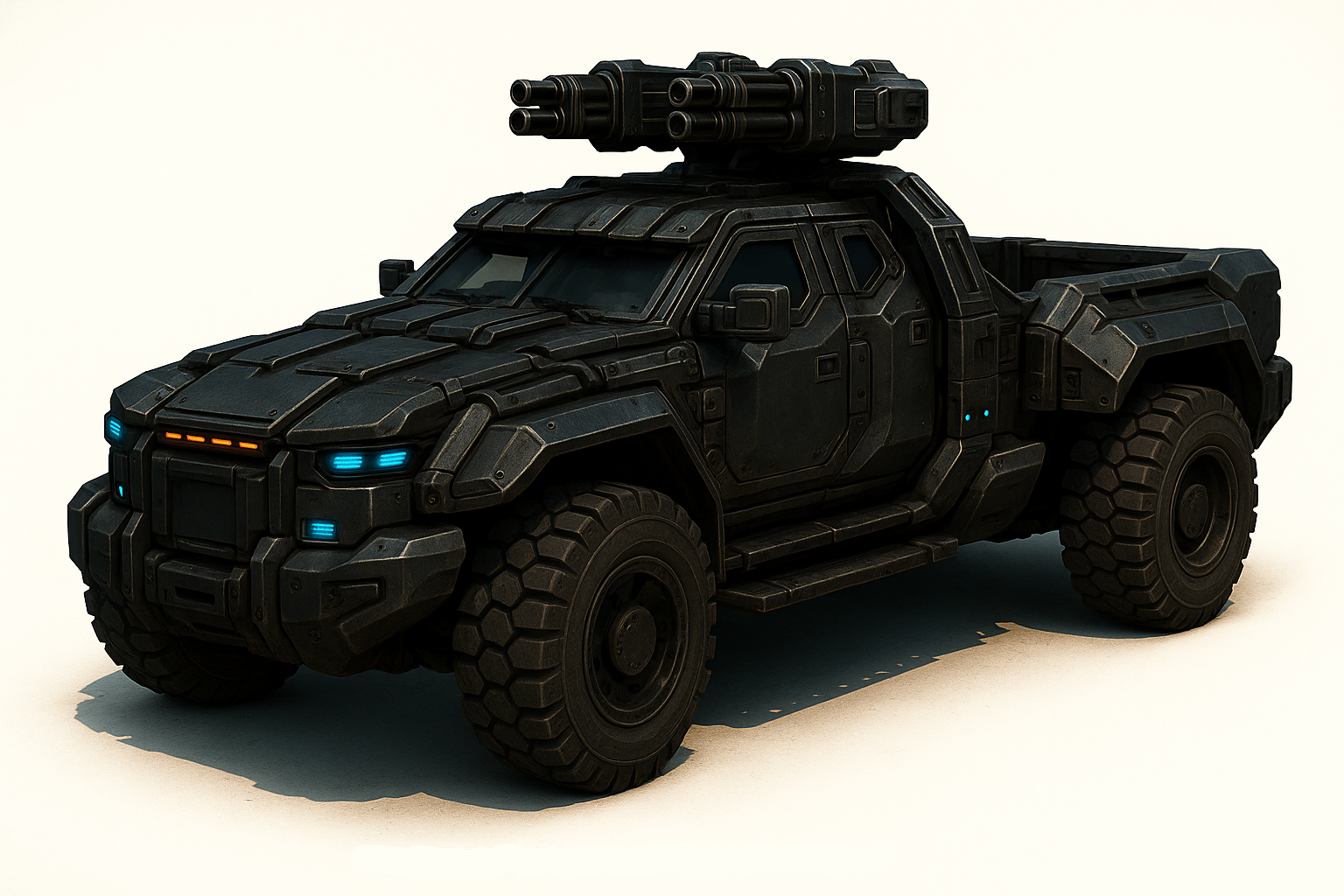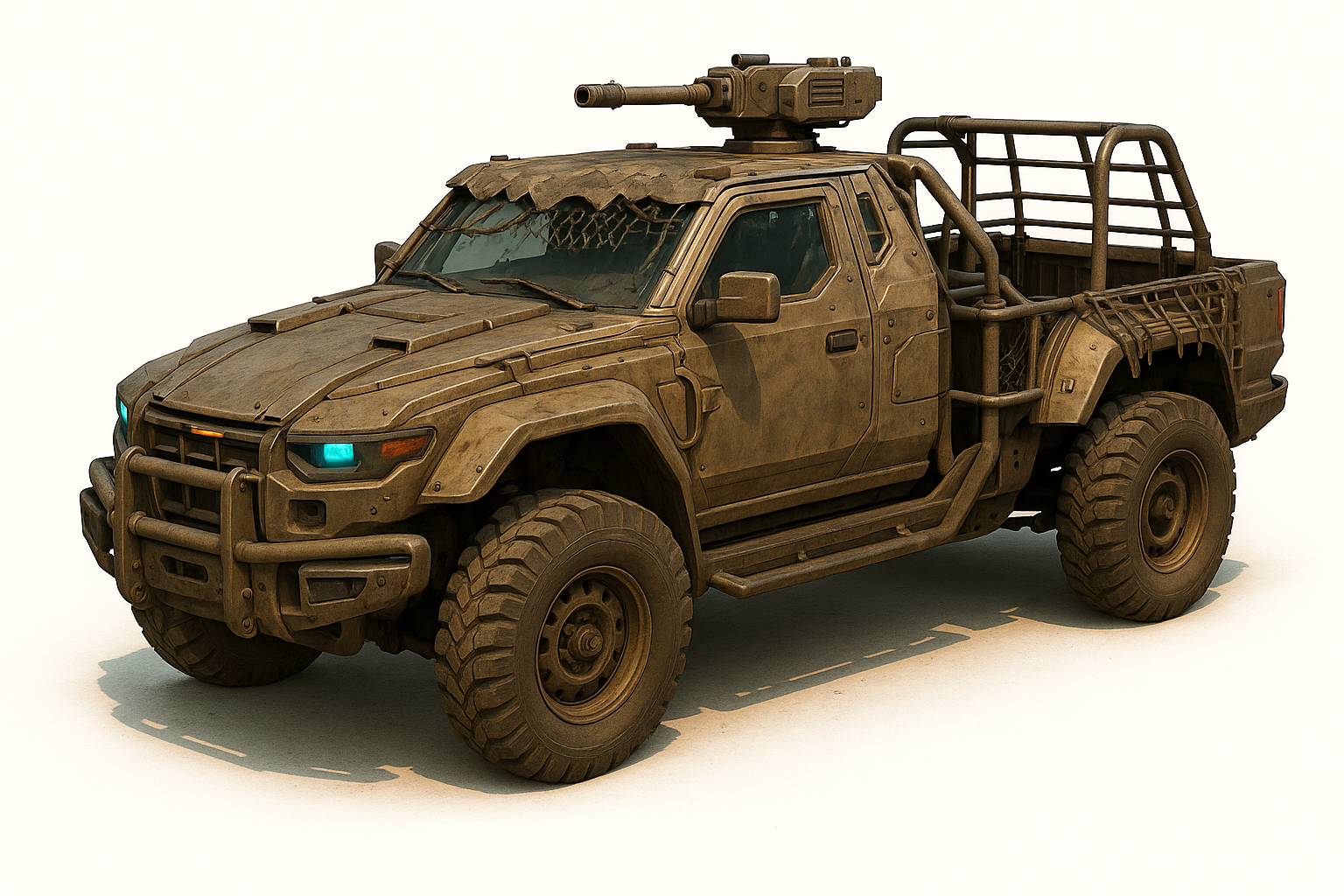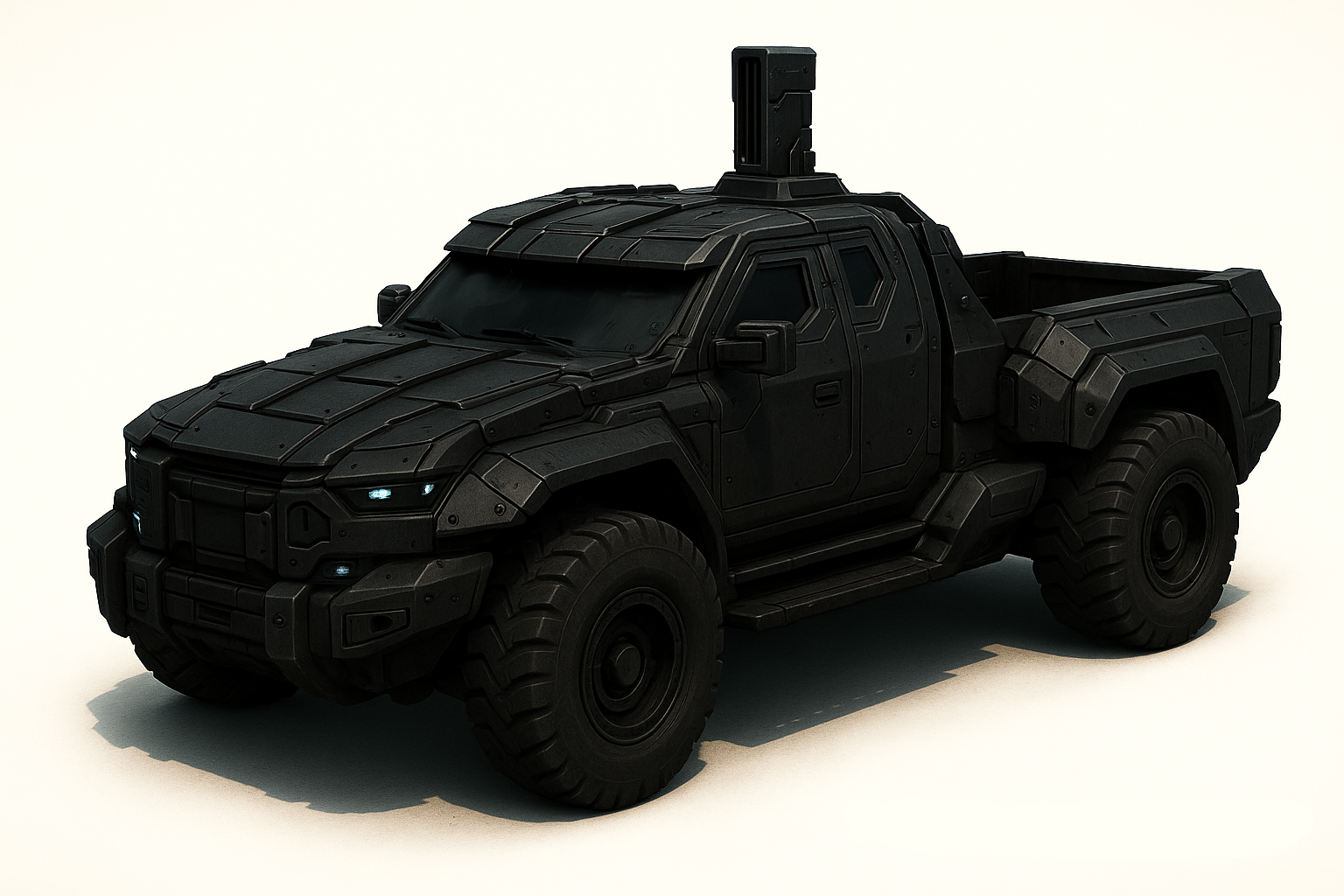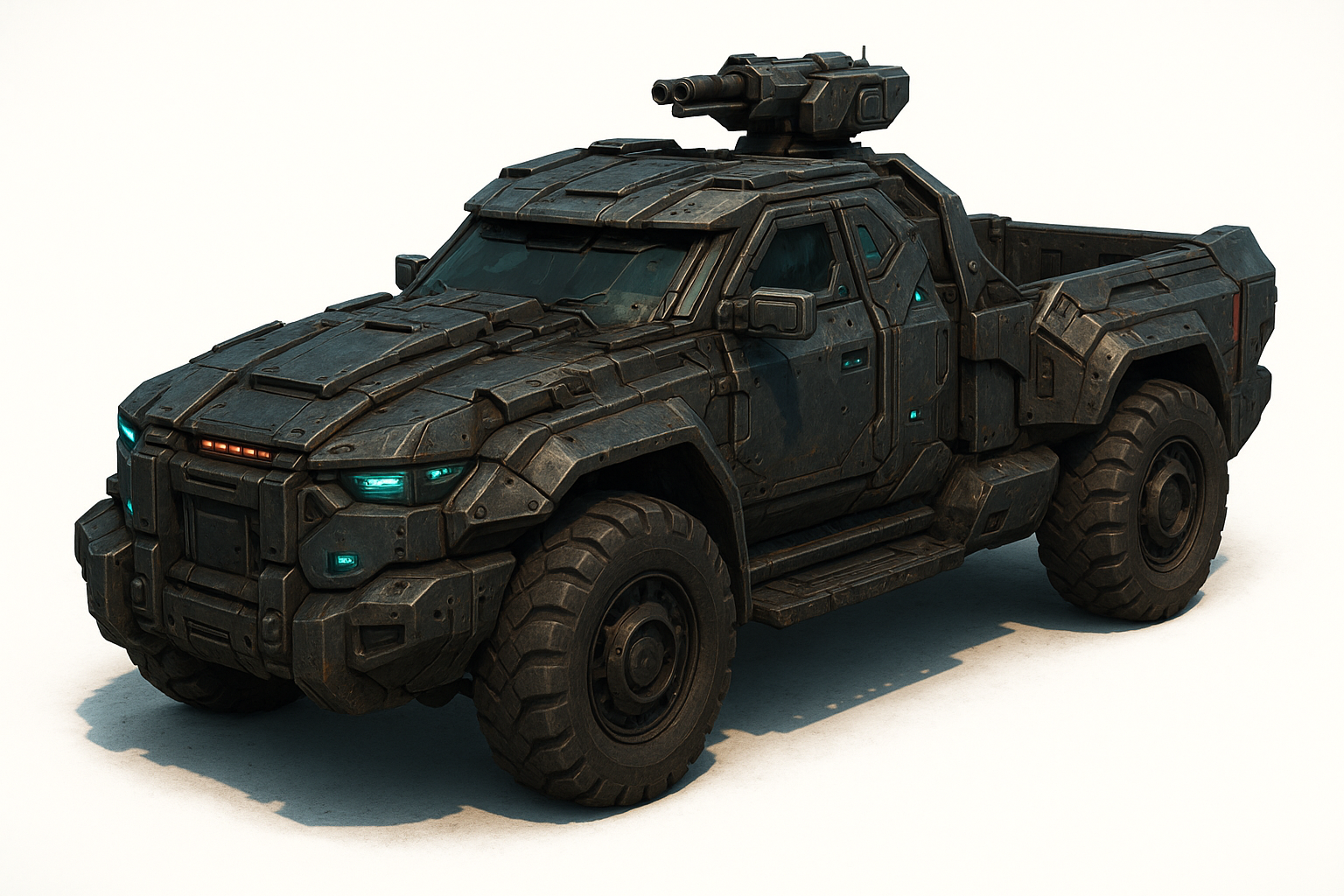T-74 Varnak Assault Hauler
The T-74 Varnak Assault Hauler, colloquially known as the Wraithmaw, is an armorer ground vehicle designed and favored by syndicate enforcers, urban raiding parties, and freelance mercenary crews across Thauzuno’s decaying sprawl. It comes equipped with a low-resistant six-chamber drivetrain, 8-turbo speed Hydro-cell engine, and a manned 25mm turret. The Varnak’s armored chassis is constructed from ferrocarbon laminar composites—resistant to kinetic impact, EMP, and most street-grade munitions. Internally, the Wraithmaw seats up to two operatives, with neural-synced targeting for the driver and gunner. The central dash is more of a threat-control interface than a dashboard—housing encrypted syndicate nodes, autonomous defense command links, and short-range jamming toggles. Street legends say no Varnak has ever been seized intact.
Design details
The T-74 Varnak isn’t built for beauty—it’s built to outlast light-to-medium fire, slum riots, and syndicate betrayals. Its design philosophy leans into intimidation: flat-panel ferrocarbon over a hex-reinforced exoskeleton, angled for ricochet geometry and nerve-wracking silhouette. Every bolt and seam is pressure-sealed; every surface matte-coated in ash-deflecting particulate to reduce thermal and radar signature. This machine looks like it crawled out of a warzone and decided to stay angry. The wheel wells are overbuilt and armored, swallowing terrain with quad-mounted torque converters that adjust dynamically to shifting debris or unstable structures. Mud, slag, crushed bone—it moves through all of it like it’s just more ground to claim.
The frontal array features integrated kinetic pulse bars—low-frequency impact generators that scatter crowds, clear light barricades, and destabilize opposing vehicles. The front bumper isn’t a bumper—it’s a breaching wedge wrapped in tri-layer impact gel, capable of punching through cinderblock or corrugated barriers at speed without decelerating. Headlamps are recessed into shatter-resistant shells, fitted with adjustable hue filters to counteract optical distortion grenades or blinding flares. Every inch of the vehicle's profile is angled with one purpose: don’t give enemies anything to grip, anchor, or latch explosives onto. And if they try? The undercarriage is slab-armored, self-cleansing, and tuned to detonate mines prematurely before they get close enough to kiss the belly.
Internally, the layout is less cockpit and more combat nest. Controls are haptic-linked—no steering wheel nonsense. The driver and gunner operate from suspended armored thrones mounted on shock columns that auto-adjust based on acceleration, impact, and threat proximity. The dash is curved like a command trench, embedded with flick-switch toggles, threat-detection overlays, and encrypted syndicate channels hardwired through double-blind frequency hops. No exposed wires. No soft panels. Even the cabin lighting is adjustable down to infrared hues for night raids or black-zone ops. When you're in the Wraithmaw, you’re not just driving—you’re commanding a weapon that pretends to be a truck.
Armament
The Wraithmaw's main armament is turret-mount neural-linked autocannon. It’s a centerline-installed, recoil-compensated 25mm belt-fed death dispenser, stabilized through gyroscopic rigs and shock-ring insulation. The standard syndicate loadout includes dual-drums: one of kinetic tungsten flechettes for hardened targets and light armor, the other loaded with compressed thermite-tipped shatter rounds designed to burst on contact and spill fire through ventilation grates and viewport gaps. The weapon cycles through fire modes—short burst, sustained rip, or overdrive full-saturate mode—depending on operator intent. It’s the kind of weapon that clears intersections, repels rooftop ambushers, and deletes doors like they're made of wet paper.
Secondary hardpoints are available on either fender, typically reserved for light modular systems. Some units carry six-barrel dart-casters that fire razor-tipped silent quarrels in fan-shaped arcs—deadly for close-quarter defense in alleyway bottlenecks. Others mount flash-pulse projectors calibrated to disorient sentries, or hull-mounted grenade dispensers wired into the undercarriage to drop detonation clusters beneath pursuit vehicles. Wraithmaw crews often install field-swappable racks on the turret base, including deployable netcasters or smoke vector launchers. The vehicle isn’t just a gun platform. It’s a rolling suppression perimeter, a threat amplifier, a mobile warning shot for the entire block.
Tertiary defenses are passive and brutal. The outer shell is rigged with low-frequency acoustic disruptors that can trigger nausea and disorientation in unshielded personnel within a 12-meter radius. Hull-embedded jammers confuse drone targeting, GPS tethering, and low-range audio pickup. Even if the vehicle’s weapons go cold, the Varnak remains a presence—a threat aura in motion. Most smart crews don’t even fire the first few minutes of an engagement. They just roll up slow, let the turret turn, and wait for the street to clear. The Wraithmaw makes its point without saying a word.
Storage capacity
The Wraithmaw is deceptively versatile in terms of cargo. The rear cargo bed—reinforced with hex-rib alloy plating—can carry over 1,200 kg of mission-ready supplies, personnel gear, or recovered syndicate assets. It features embedded lock-rails for crate bracing, sealed compartments under the lining for smuggling small ordnance or sensitive tech, and shock-mount loops built to secure crash-stabilized field stretchers. On most missions, it’s used to haul breach packs, fusion cutters, drone nests, or even live prisoners in containment modules magnetically clamped to the bed rails. There's no decor. Just raw, stripped utility.
Internally, the cab’s rear wall includes a tri-rail rack for sniper rifles, anti-armor carbines, and breach tools, locked with syndicate-coded biometric clamps. Beneath the floor panels are two insulated storage vaults—one temperature-stabilized for preserving organic samples or meds, the other lead-lined and encrypted for data wafers, payment slabs, or unauthorized neurotech. The overhead channel, rarely noticed by civilians, holds soft-shell bags for personal kit, backup ammo, and collapsible drone units. Veteran crews know the Wraithmaw is not just a transport—it’s a rolling cache. Everything you need to start or end a street war is somewhere in the frame. Field customization is common, even expected. Some outfits install retractable load bridges from the bed to allow quick offload of bikes. Others bolt down reinforced cages or hydraulic lift arms to grab and move debris, cargo, or people. One Ravvaar-aligned team even ran a Wraithmaw retrofitted with a double-chamber mortar nest hidden beneath a false floor panel—firing vertical HE shells in close quarters before driving straight through the chaos. If there's space, the Wraithmaw can use it. And if there isn't, crews make space with tools, force, or fire.
Variants
- The T-74V Null-Op Enhanced is the apex variant reserved for high-clearance operations—black-badge raids, territory liquidation, and executive-level asset extraction. Outfitted with quadruple-layer reactive plating, motion-dampened recoil trays, and neural-spliced weapon integration, it’s as close as one gets to legally sanctioned overkill. The entire chassis is reinforced with a secondary shell exo-frame, giving it the raw weight to batter through makeshift barricades and the kinetic resistance to shrug off improvised explosive traps. Its turret mounts are factory-fused to accept heavier payloads, like twin-linked kinetic gunners or armor-ripping boltcasters that strip enemy cover in seconds. Navigation is powered by a hardened threat-sensing logic kernel that pre-processes potential engagement vectors before the crew even sees the threat. Most enemies don’t know they’ve been targeted until they’re horizontal and missing a limb.
- The T-74S Dustgrinder is the opposite in temperament: a stripped-down, torque-optimized variant built for speed and endurance across harsh terrain—slums, deserts, industrial exclusion zones. Dustgrinders dump armor in favor of efficiency. The frame is lighter, the drivetrain tuned for traction over wasteland surfaces and degraded roads. Instead of full combat suites, Dustgrinders rely on misdirection: hull-integrated camo mesh, dynamic temp-dampers, and a reduced signature profile to slip through contested zones unseen. These units are the hauler of choice for black-market runners, post-raid evac crews, and long-haul syndicate operatives who need to move goods—illegal, delicate, or both—across unfriendly ground. Popular mods include reinforced air filters, hydration coils, rear cage extensions, and rear-mounted flash-dazzlers to scatter pursuers during fast extraction.
- The T-74X Graveweight is the rarest and most unsettling variant—used exclusively in deniable operations where witnesses are not just discouraged, but unacceptable. Outwardly, it resembles the standard Varnak, but its skin is smarter—laced with matte cloaking pigment and composite coating that suppresses heat bleed and renders LIDAR scatter patterns inconsistent. The cannon turret is modular, often swapped out for a vertical-launch penetrator pod, breaching hammer rig, or variable-speed spike launcher for precise wall entries or silent takedowns. What makes the Graveweight infamous is its interior: an adaptive kill-switch system that triggers instant data wipe, hull detonation, or black-smoke concealment if tampered with. The Graveweight doesn’t break down. It doesn’t get salvaged. If compromised, it dissolves into a wrecked chassis with no usable intelligence. Operatives call it “the ghost with wheels.” If it shows up on your street, you’re either already dead—or about to disappear with it.
T-74 Varnak Assault Hauler
Production Information
Type
Armored Tactical Assault Hauler
DesignationUrban Siege Platform/High-Risk Extraction/Forward Shock Deployment
ManufacturerKorvess DevWorks
Vehicle CostⱽҜ122,000 (Base)
ⱽҜ176,000 (Null-Op Enhanced)
ⱽҜ94,650 (Dustgrinder)
ⱽҜ560,500 (Graveweight)
Technical Information
Length
6.5 meters (21.3 feet)
Weight4,980 kg (10,981 lb.)
Max Speed160 km/h (99.4 mph)
Acceleration0–60 km/h in 5.6 seconds
Drive SystemQuad-wheel torque-split suspension
Fuel SourceHydro-cell
Armor PlatingMulti-phase ferrocarbon laminate with dynamic shock-skin substrate
Crew Capacity2 (Driver and gunner)







Comments